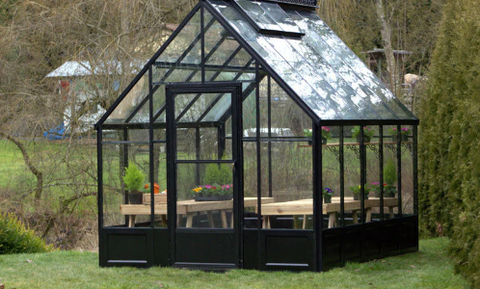Wood and aluminum stand as two formidable greenhouse framing contenders, each with its unique set of advantages. Whether you're a seasoned gardener or just beginning your journey, making an informed decision between these materials is crucial for creating the ultimate greenhouse environment.
Join us as we explore the merits of aluminum-framed marvels from brands like Janssens Greenhouses and Cross Country Greenhouses while considering the unique alternative of Solexx Greenhouses. It's time to embark on a journey where strength, durability, and precision climate control take center stage in your horticultural pursuits.
Aluminum Greenhouses Stand the Test of Time
When it comes to durability, aluminum greenhouses take the crown. They are impervious to rot, pests, and the ravages of time. Unlike wood, aluminum doesn't warp, crack, or succumb to termites. Your investment in an aluminum-framed greenhouse is, quite literally, a long-term commitment to your gardening passion.
Built to Withstand Harsh Conditions
Aluminum greenhouses are ideal for regions with unpredictable weather patterns. They can withstand heavy snow loads, gusty winds, and torrential rain without breaking a sweat. Their robust frames ensure the safety of your plants, making them a dependable choice for year-round gardening.
Energy Efficiency: Aluminum Takes the Lead in Optimal Insulation
Greenhouses should offer a stable climate for your plants, and here, aluminum has the edge. Aluminum frames such as Royal Victorian or EOS T-shaped glass greenhouses are designed with optimal insulation in mind. They minimize heat loss during chilly nights and prevent excessive heat buildup during scorching summers. This translates to a more consistent and controlled environment for your plants, promoting healthy growth.
Energy-Efficient Design
Aluminum-framed greenhouses are synonymous with energy efficiency. They are designed to accommodate advanced climate control systems, like exhaust fans for greenhouses. These fans ensure proper air circulation and help maintain the desired temperature and humidity levels. This not only benefits your plants but also reduces energy consumption, aligning with sustainable gardening practices.
Minimal Upkeep
One of the undeniable advantages of aluminum greenhouses is their low maintenance requirements. Unlike wooden counterparts, aluminum frames do not demand regular staining, sealing, or painting. Once assembled, they remain pristine with minimal effort, allowing you to focus your energy on what truly matters – nurturing your plants.
Elegant Aesthetics
Aluminum greenhouses exude an air of modern elegance. Their sleek, contemporary design blends seamlessly with any garden setting. Whether you're a minimalist gardener or an aficionado of clean lines, aluminum greenhouses from brands like Janssens Greenhouses offer an aesthetic edge that enhances your gardening space.
Aluminum Frames, Diverse Options
Aluminum greenhouses come in a wide range of sizes and styles to suit every gardener's needs. From compact models ideal for limited garden space to grand structures like the Janssens Royal Victorian Greenhouses, there's an aluminum-framed greenhouse for everyone. Their adaptability allows you to create a gardening haven tailored to your unique aspirations.
Cross Country Greenhouses: A Testament to Versatility
Cross Country Greenhouses, a revered name in the horticultural world, offers a diverse selection of greenhouses. Their aluminum-framed models exemplify versatility, accommodating different growing requirements. Whether you're an orchid enthusiast, a vegetable gardener, or a lover of exotic plants, Cross Country Greenhouses has a solution that suits your botanical pursuits.
Solexx Greenhouses: A Unique Alternative
While we passionately advocate for aluminum greenhouses, it's worth mentioning a unique alternative – Solexx 16 ft x 16 ft Conservatory Greenhouse G-316. These greenhouses feature a twin-wall covering that provides excellent insulation and diffused light. Although not framed in aluminum, they offer an intriguing balance of strength and light transmission, making them a noteworthy consideration.
Here's a technical breakdown of the advantages of aluminum over wood in greenhouse structures:
Material Properties: Aluminum
- Density: Approximately 2.7 g/cm³
- High strength-to-weight ratio
- Excellent corrosion resistance
- Non-porous surface
- Minimal expansion and contraction with temperature changes
- Long-term durability
Wood
- Density varies by wood type (e.g., cedar, redwood, pine)
- Natural organic material
- Vulnerable to decay, insects, and fungal growth
- Absorbs moisture, leading to expansion and contraction
- Requires protective treatments like staining, sealing, or painting
- Strength and Load-Bearing Capacity:
Resistance: Aluminum
- High tensile strength
- Capable of withstanding heavy loads, including snow and wind
- Ideal for larger greenhouse structures
- Structural integrity maintained over time
Wood
- Lower tensile strength compared to aluminum
- Susceptible to warping, bending, and structural degradation over time
- It may require additional reinforcements for larger greenhouses
- Prone to damage from heavy snow and strong winds
Maintenance Requirements: Aluminum
- Minimal maintenance required
- Resistant to rot, pests, and corrosion
- No need for regular painting or staining
- Periodic cleaning and lubrication of moving parts (e.g., hinges) may be necessary
Wood:
- Requires ongoing maintenance to prevent decay, insect infestations, and deterioration
- Regular painting, sealing, or staining needed to protect the wood
- Inspection and repairs necessary to maintain structural integrity
Energy Efficiency: Aluminum
- Designed for optimal insulation
- Reduces heat loss during cold periods
- Prevents excessive heat buildup during hot weather
- Supports stable and energy-efficient greenhouse climates
Wood:
- Limited insulation properties
- More susceptible to temperature fluctuations
- May require additional insulation measures to achieve consistent climate control
The Bottom Line: Aluminum Prevails
In the wooden vs. aluminum frame greenhouse showdown, aluminum emerges as the winner in terms of strength, durability, energy efficiency, low maintenance, aesthetics, and versatility. Brands like Janssens Greenhouses and Cross Country Greenhouses have embraced aluminum, delivering premium greenhouse solutions that cater to the needs of modern gardeners.
So, whether you're planning to shop for an aluminum-framed masterpiece from Janssens Greenhouses, seeking the versatile options offered by Cross Country Legacy 8X8 Glass Greenhouse with Polycarbonate Roof, or exploring alternatives like Solexx Greenhouses, remember that aluminum is your steadfast ally in creating the perfect greenhouse environment for your botanical treasures. Let Mulberry Greenhouses help you take your greenhouse gardening journey to the next level.
Shop today or call us today!




